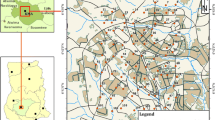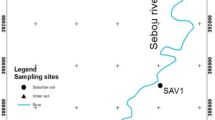Abstract
Several physiologically based extraction procedures have been proposed to estimate the fraction of the potentially toxic element content that would be bioaccessible in the human gastro-intestinal tract following accidental ingestion of soil. Many of these procedures are complex, they have been applied to a very limited range of soils, and most work has focussed on arsenic and lead. In the present study, a simplified, two-stage extraction, simulating the human stomach and intestine, was developed and applied to urban soil samples from ten public-access areas in the City of Torino, Italy. The human oral bioaccessibility of chromium, copper, nickel, lead and zinc was estimated. Lead and zinc bioaccessibilities were found to be higher in the stomach, but chromium was more bioaccessible in the intestine. Analyte concentrations were higher in roadside soils than in soils from parks. A higher proportion of the soil metal content was found in bioaccessible forms at roadsides than in parks. Comparison of the current findings with results of earlier work involving sequential extraction of the same soils indicated that the sequential procedure gave a relative, but not an absolute, indication of bioaccessibility. Calculations based on the bioaccessible analyte concentrations suggest that ingestion of only 2–3 g of some of the roadside soil samples from Torino could deliver the tolerable daily oral intake of chromium, nickel and lead to a 20-kg child. The developed procedure is useful for preliminary screening of soils and prediction of whether their bioaccessible metal contents are likely to pose a risk to human health.

Similar content being viewed by others
References
Bacon JR, Davidson CM (2008) Is there a future for sequential extraction? Analyst 133:25–46
Biasioli M, Barberis R, Ajmone-Marsan F (2006) The influence of a large city on some soil properties and metals content. Sci Total Environ 356:154–164
Davidson CM, Urquhart GJ, Ajmone-Marsan F, Biasioli M, Duarte AC, Diaz-Barrientos E, Grcman H, Hossack I, Hursthouse AS, Madrid L, Rodriguez S, Zupan M (2006) Fractionation of potentially toxic elements in urban soils from five European cities by means of a harmonised sequential extraction. Anal Chim Acta 565:63–72
DEFRA (Department for the Environment, Food and Rural Affairs) and the Environment Agency (2002) Contaminants in soils: collation of toxicological data and intake values for humans. R&D Publications TOX 4 Chromium; TOX 6 Lead; and TOX 8 Nickel
Hursthouse A, Tognarelli D, Tucker P, Ajmone-Marsan F, Martini C, Madrid L, Madrid F, Diaz-Barrientos E (2004) Metal content of surface soils in parks and allotments from three European cities: initial pilot study results. Land Contam Reclam 12:189–196
Intawongse M, Dean JR (2006) In vitro testing for assessing the oral bioaccessibility of trace elements in soils and food samples. Trends Analyt Chem 25:876–886
Juhasz AL, Weber J, Smith E, Naidu R, Marschner B, Rees M, Rofe A, Kuchel T, Sansom L (2009) Evaluation of SBRC-Gastric and SBRC-Intestinal methods for the prediction of in vivo relative lead bioavailability in contaminated soils. Environ Sci Technol 43:4503–4509
Madrid L, Diaz-Barrientos E, Ruiz-Cortés E, Reinoso R, Biasioli M, Davidson CM, Duarte AC, Grčman H, Hossack I, Hursthouse AS, Kralj T, Ljung K, Otabbong E, Rodrigues S, Urquhart GJ, Ajmone-Marsan F (2006) Variability in concentrations of potentially toxic elements in urban parks from six European cities. J Environ Monit 8:1158–1165
Madrid F, Biasioli M, Ajmone-Marsan F (2008) Availability and bioaccessibility of metals in fine particles of some urban soils. Arch Environ Contam Toxicol 55:21–32
Oomen AG, Hack A, Minekus M, Zeijdner E, Cornelis C, Schoeters G, Verstraete W, Van de Wiele T, Wragg J, Rompelberg CJM, Sips AJAM, Van Wijnen JH (2002) Comparison of five in vitro digestion models to study the bioaccessibility of soil contaminants. Environ Sci Technol 36:3326–3334
Poggio L, Vrscaj B, Schulin R, Hepperle E, Ajmone-Marsan F (2009) Metal pollution and human bioaccessibility of topsoils in Grugliasco (Italy). Environ Pollut 157:680–689
Ruby MV, Davis A, Schoof R, Eberle S, Sellstone CM (1996) Estimation of lead and arsenic bioavailability using a physiologically based extraction test. Environ Sci Technol 30:422–430
Ruby MV, Schoof R, Brattin W, Goldade M, Post G, Harnois M, Mosby DE, Casteel SW, Berti W, Carpenter M, Edwards D, Cragin D, Chappell W (1999) Advances in evaluating the oral bioaccessibility if inorganics in soil for use in human health risk assessment. Environ Sci Technol 33:3697–3705
Selinus O (ed) (2005) Essentials of Medical Geology. Elsevier, Amsterdam
Wong CSC, Li X, Thornton I (2006) Urban environmental geochemistry of trace metals. Environ Pollut 142:1–16
Author information
Authors and Affiliations
Corresponding author
Rights and permissions
About this article
Cite this article
Sialelli, J., Davidson, C.M., Hursthouse, A.S. et al. Human bioaccessibility of Cr, Cu, Ni, Pb and Zn in urban soils from the city of Torino, Italy. Environ Chem Lett 9, 197–202 (2011). https://doi.org/10.1007/s10311-009-0263-5
Received:
Accepted:
Published:
Issue Date:
DOI: https://doi.org/10.1007/s10311-009-0263-5




